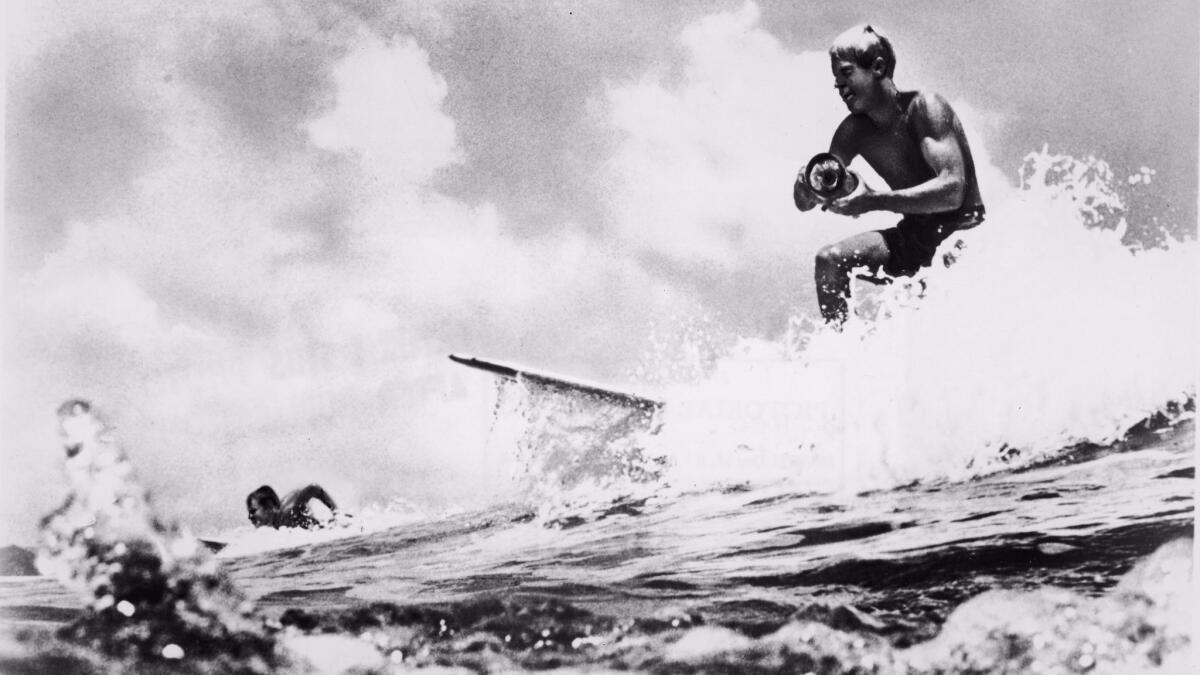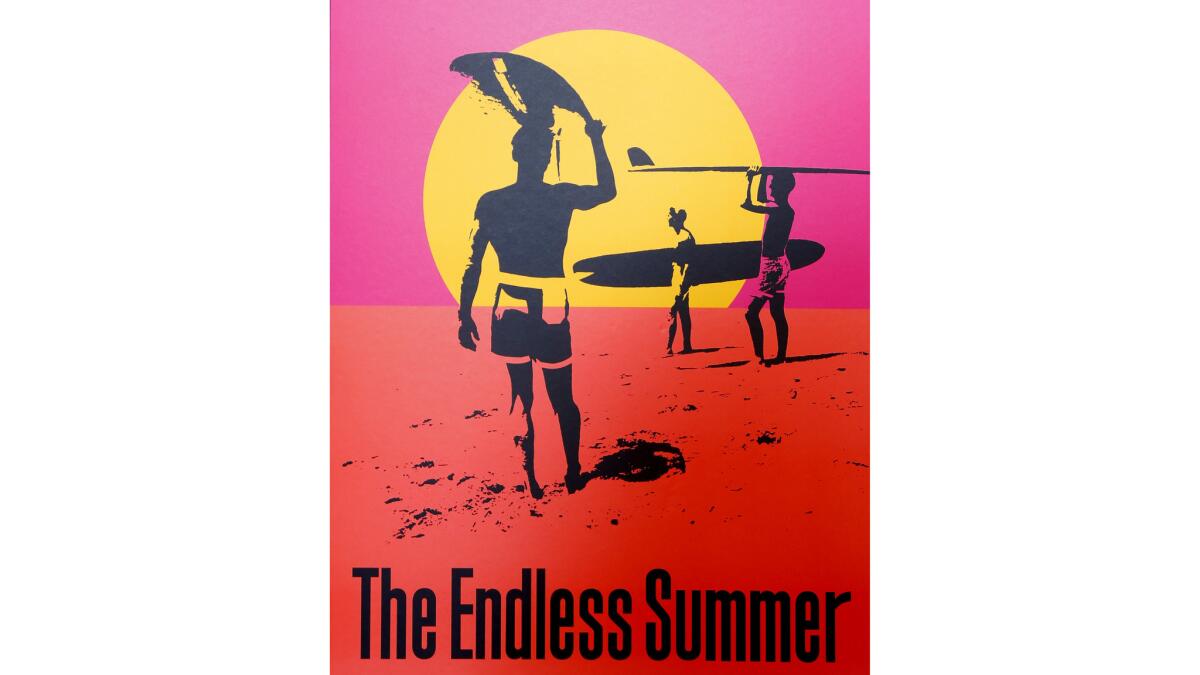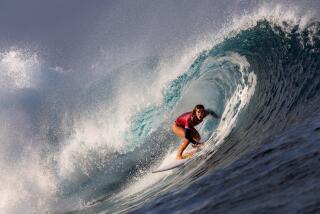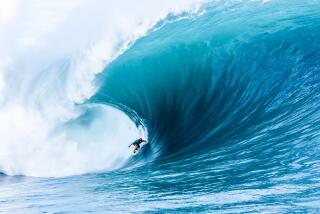Bruce Brown, who turned surfing into a cultural phenomenon with ‘The Endless Summer,’ dies at 80

- Share via
On a tight budget and with an armful of surfboards, Bruce Brown helped introduce America to surfing with a story of two friends trotting around the world, in chase of the perfect wave.
Though it was considered a long shot at best by distributors, there was something about “The Endless Summer” that resonated with audiences from New York City to Santa Monica, marking a cultural turning point for a sport — a lifestyle, Brown and others insisted — that had been largely viewed as a mind-numbing distraction for aimless teens.
For the record:
12:15 p.m. Dec. 18, 2017For the record: An earlier version of this story described the Baja 1000 as a road race. It is an off-road race.
The film came to be regarded one of the finest surf movies ever made, beckoning people to the shore and romanticizing the idea that maybe there really was nothing wrong with trading the conventions of the working world for a simpler life on the water.
A lifelong surfer and motorcycle rider, Brown died Sunday at his ranch north of Santa Barbara, his company website, Bruce Brown Films, announced. He was 80.
“Thank you for showing us the world as you saw it, #Bruce Brown,” surfer Kelly Slater tweeted.
Brown was among a small group of filmmakers who barnstormed Southern California in the early 1960s with low-budget films about surfing and the beach lifestyle. Some of Brown’s early films lacked a soundtrack, forcing him to narrate the movies as he toured up and down the coast.
While the films often played to small hardcore gatherings at school assemblies or rented halls, “The Endless Summer” found a national audience and helped transform surfing intro a cultural phenomenon. But it took a certain element of guerrilla marketing to get distributors to even pay attention to the movie.
Roger Riddell, who worked on the film and traveled with Brown on the exhausting months-long odyssey around the world, recalled Monday that Brown was so certain audiences would enjoy his movie he rented a theater in Wichita, Kan., in the dead of winter to prove that, even in a place hundreds of miles from the ocean, people would line up to see “The Endless Summer.”
The crowds arrived, but distributors remained unconvinced. So Brown rented a movie house in New York to the show the film. It was supposed to play for a week. It showed for 18 months.
“There was something about that movie,” Riddel said. “People would come back again and again to see it.”

The premise of the film was simple, yet compelling: two surfers staying in the sunshine of summer by following the seasons around the world. The film was narrated by Brown and starred Mike Hynson and Robert August, two surfers and board shapers.
Made on a budget of $50,000, the film was compiled on the fly as Brown and his small crew loped from Hawaii to New Zealand to the shores of Ghana, crossing the equator four times while recording nine miles of film. In India, customs agents confiscated their surfboards. In Kenya, they witnessed a revolution. And in the aquamarine waters of the Indian Ocean, they dodged sharks and carnivorous stonefish.
Brown told The Times in 1991 that he could never quite put his finger on the film’s popularity or explain why a healthy chunk of America’s male adolescents had the movie’s poster pinned to their bedroom walls. But August had a theory.
“In the Vietnam era, everybody needed something like that,” he told The Times. “God, you felt good when you left the theater.”
Steve Pezman, the former publisher of Surfer magazine, said the movie showed surfing as poetry as much as a sport. In many ways, he said, it was a statement about the values of a new generation.
“It was a bunch of kids saying to their parents, many of whom were children of the Depression and were into security, that there are other things important in life.”
The film was reprised three decades later in “The Endless Summer II,” which retraced the footprints of Hynson and August and showed how surfing had changed the look and the vibe of the coastline from California to South Africa.

The film was also sobering. When the crew returned to Cape St. Francis in South Africa, looking for the miles of unblemished sand and the near-perfect glassy curls of surf, the scene was altered. Hundreds of condos covered the shoreline, and vegetation had crept over the sand. . It looked, for all the world, like Orange County.
“I saw that and the first thing I said was ‘Noooo,’ ” recalled Robert “Wingnut” Weaver, one of the two surfers featured in “The Endless Summer II.”
Brown also was nominated for an Academy Award for his 1971 documentary “On Any Sunday,” a film about the lifestyles of motorcycle racers. Actor Steve McQueen helped produce it. As with surfing, Brown put motorcycle riding and racing in a sunnier context. Once associated with the Hell’s Angels, it was connected with the outdoor enthusiast.
Brown’s eldest son, Dana, is also a documentary filmmaker who made “Step Into Liquid” and “Dust to Glory,” a look at the competitors and the challenges of the Baja 1000 off-road race.
Born in San Francisco, Brown grew up in Long Beach, where he first began riding the rolling breakers in the entrance to Alamitos Bay before the Long Beach breakwater was completed, which effectively killed surfing in the beach city.
In his later years, Brown retreated to a ranch north of Santa Barbara, where he spent his days surfing, riding motorcycles and racing sprint cars.
Twitter: @stephenmarble
UPDATES:
3:40 p.m.: This article was updated with additional details and interviews.
The article was originally published at 10:25 a.m.
More to Read
Start your day right
Sign up for Essential California for the L.A. Times biggest news, features and recommendations in your inbox six days a week.
You may occasionally receive promotional content from the Los Angeles Times.







